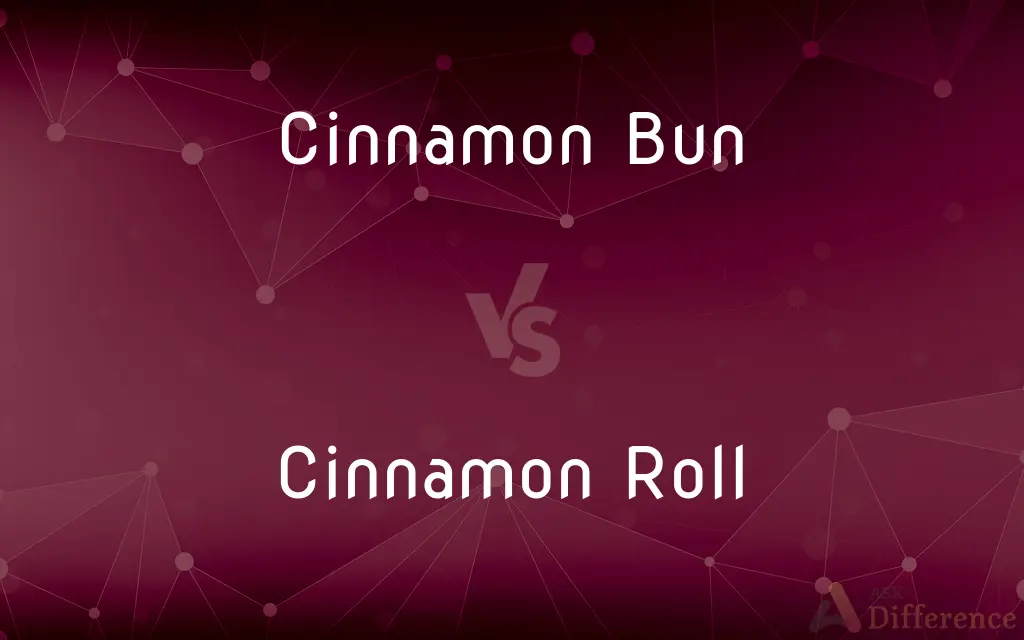Cinnamon Bun vs. Cinnamon Roll — What's the Difference?
Edited by Tayyaba Rehman — By Maham Liaqat — Published on March 2, 2024
Cinnamon buns and cinnamon rolls are similar pastries, both featuring sweet dough and cinnamon filling, but buns are often topped with a sticky glaze and nuts, while rolls are typically finished with a cream cheese frosting.

Difference Between Cinnamon Bun and Cinnamon Roll
Table of Contents
ADVERTISEMENT
Key Differences
Cinnamon buns and cinnamon rolls share a base of sweet, yeasted dough and a filling primarily made of cinnamon, sugar, and butter. The main distinction lies in their toppings and sometimes in their dough texture. Cinnamon buns are known for their sticky, caramel-like glaze that often incorporates nuts such as pecans or walnuts. This glaze is applied before baking, resulting in a moist and sticky surface as it cooks. Cinnamon rolls, in contrast, are typically topped with a rich cream cheese frosting that's added after baking, giving them a creamy texture that contrasts with the soft dough.
The dough for cinnamon rolls is often lighter and fluffier, aimed at creating a tender bite that pairs well with the smooth, sweet frosting. Cinnamon buns might have a slightly denser dough to support the weight of the glaze and nuts, contributing to their hearty texture. This difference in dough texture can affect the overall eating experience, with buns offering a chewier bite and rolls providing a melt-in-your-mouth feel.
In terms of serving, cinnamon buns, with their sticky glaze, are often seen as a more decadent option, suitable for special occasions or as a treat in bakeries and coffee shops. Cinnamon rolls, with their cream cheese frosting, are a popular choice for breakfast or brunch, easily found in both homemade and commercial versions.
Culturally, both pastries have roots in Scandinavian and German baking, but they have been widely adopted and adapted in North America. The choice between a bun and a roll can come down to personal preference for either the sticky sweetness of a bun or the creamy indulgence of a roll.
Despite these differences, both cinnamon buns and rolls are often enjoyed warm, with the heat enhancing the flavor of the cinnamon and melting the topping slightly, which makes for a comforting and indulgent treat.
ADVERTISEMENT
Comparison Chart
Topping
Sticky glaze, often with nuts
Cream cheese frosting
Dough Texture
Slightly denser to support toppings
Lighter and fluffier
Serving Occasion
Seen as more decadent, for special treats
Common for breakfast or brunch
Cultural Roots
Scandinavian and German baking traditions
Also from Scandinavian and German origins, widely popular in North America
Taste Experience
Chewy bite with a moist, sticky surface
Tender bite with a creamy, smooth frosting
Compare with Definitions
Cinnamon Bun
A pastry with a sticky glaze and nuts on top.
The cinnamon bun was covered in a caramel-like glaze and chopped pecans.
Cinnamon Roll
A pastry topped with cream cheese frosting.
The cinnamon roll was generously frosted with a smooth cream cheese icing.
Cinnamon Bun
Often considered a special treat.
For our anniversary, we shared a cinnamon bun from our favorite bakery.
Cinnamon Roll
Characterized by a light, fluffy dough.
The dough of the cinnamon roll was so soft, it practically melted in my mouth.
Cinnamon Bun
Features a chewy bite.
The chewiness of the cinnamon bun was complemented by its sticky topping.
Cinnamon Roll
Offers a tender, melt-in-your-mouth feel.
The tender texture of the cinnamon roll made it a comforting treat.
Cinnamon Bun
Served warm for enhanced flavor.
The warm cinnamon bun melted the glaze slightly, making it even more delicious.
Cinnamon Roll
A popular breakfast choice.
We enjoyed cinnamon rolls with our coffee this morning.
Cinnamon Bun
Known for its hearty texture.
The dense dough of the cinnamon bun made for a satisfying snack.
Cinnamon Roll
Best enjoyed warm for a creamy topping.
Heating the cinnamon roll slightly softened the cream cheese frosting, enhancing its flavor.
Common Curiosities
Can you use the same dough for cinnamon buns and rolls?
While the base dough can be similar, rolls often use a lighter dough compared to the slightly denser dough of buns.
Are cinnamon buns and rolls served at the same temperature?
Both are often served warm to enhance the flavors and textures of their respective toppings.
How do you keep cinnamon buns and rolls fresh?
Store them in an airtight container at room temperature for a short period, or refrigerate for longer storage.
Are cinnamon rolls always topped with cream cheese frosting?
While cream cheese frosting is traditional, variations may include vanilla icing or other sweet glazes.
Do cinnamon buns and rolls originate from the same country?
Both have roots in Scandinavian and German baking, though they have evolved differently in various regions.
Can cinnamon buns and rolls be made without yeast?
Yes, there are recipes for both that use baking powder or soda, but the texture will be different from the yeasted versions.
Why do cinnamon buns sometimes have nuts?
Nuts add texture and flavor, complementing the sticky glaze of the buns.
What's the best way to reheat cinnamon buns and rolls?
Briefly in the microwave or oven until just warm, to prevent drying out the pastry or melting the frosting excessively.
What's the main difference between a cinnamon bun and a cinnamon roll?
The topping: buns have a sticky glaze with nuts, while rolls are frosted with cream cheese.
Is there a nutritional difference between cinnamon buns and rolls?
Yes, depending on the toppings and ingredients, there can be differences in calorie, sugar, and fat content.
Can you freeze cinnamon buns and rolls?
Yes, both can be frozen. For best results, freeze them without the topping and add it after reheating.
Is there a vegan version of cinnamon buns and rolls?
Yes, there are vegan recipes using plant-based ingredients for both the dough and toppings.
Can cinnamon buns and rolls be made gluten-free?
Yes, with gluten-free flour blends designed for baking, though the texture may be slightly different.
Why are cinnamon rolls popular in North America?
Their sweet flavor, comforting texture, and versatility as a breakfast or dessert item have made them widely popular.
What occasions are cinnamon buns and rolls suitable for?
They can be enjoyed as a daily treat, for special occasions, or as a comforting snack or breakfast.
Share Your Discovery

Previous Comparison
Sociopathy vs. Borderline
Next Comparison
Wisdom in D&D 5e vs. Intelligence in D&D 5eAuthor Spotlight
Written by
Maham LiaqatEdited by
Tayyaba RehmanTayyaba Rehman is a distinguished writer, currently serving as a primary contributor to askdifference.com. As a researcher in semantics and etymology, Tayyaba's passion for the complexity of languages and their distinctions has found a perfect home on the platform. Tayyaba delves into the intricacies of language, distinguishing between commonly confused words and phrases, thereby providing clarity for readers worldwide.
















































